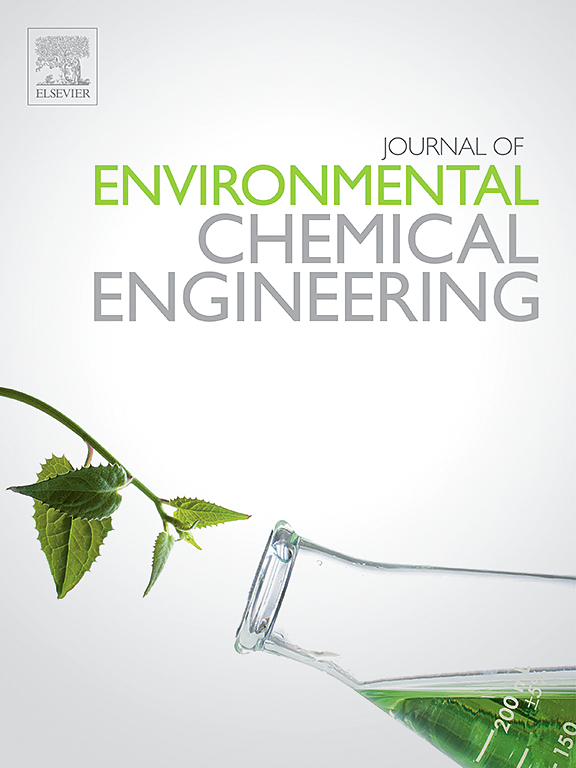邻苯二甲酸改性硫酸化微尺度零价铁去除六价铬的能力和机理
IF 7.2
2区 工程技术
Q1 ENGINEERING, CHEMICAL
引用次数: 0
摘要
机械化学硫化微尺度零价铁(S-mZVIbm)具有良好的六价铬去除性能,但容易被六价铬钝化,如何减轻钝化仍是一个难题。本研究通过球磨成功合成了邻苯二甲酸(PA,富羧基有机酸)改性的 S-mZVIbm 颗粒(PA-S-mZVIbm (4:1))。PA 对 ZVI 表面的预腐蚀有效地增加了 ZVI 的比表面积。此外,羧基还与六(七)铬发生络合反应,从而提高了六(七)铬的去除能力并减轻了钝化现象。PA-S-mZVIbm (4:1) 对六价铬的去除主要是表面的化学吸附过程,其六价铬去除能力(55.47 mg/g)分别是 PA-mZVIbm 和 S-mZVIbm 的 1.26 倍和 9.94 - 14.83 倍。PA-S-mZVIbm(4:1)和S-mZVIbm去除六价铬的电子效率均为±100%,但PA-S-mZVIbm(4:1)的铁(0)利用率至少是S-mZVIbm的15倍,这说明PA-S-mZVIbm(4:1)的性能更为优异。该研究证实,PA 改性可有效减轻 S-mZVIbm 的钝化并提高其铁(0)利用效率。本文章由计算机程序翻译,如有差异,请以英文原文为准。
Capability and mechanism of Cr(VI) removal by phthalic acid modified sulfidated microscale zero valent iron
Mechanochemically sulfidated microscale zero valent iron (S-mZVIbm) exhibits promising Cr(VI) removal performance but is prone to be passivated by Cr(VI), how to mitigate the passivation is still a challenge. In this study, we successfully synthesized phthalic acid (PA, carboxyl-rich organic acid) modified S-mZVIbm particles (PA-S-mZVIbm (4:1)) through ball milling. The pre-corrosion of the ZVI surface by PA effectively increased the specific surface area of ZVI. Additionally, the carboxyl groups complexed with Cr(VI), thereby enhancing its Cr(VI) removal capacity and alleviating the passivation. The Cr(VI) removal by PA-S-mZVIbm (4:1) was mainly a chemisorption process on the surface and its Cr(VI) removal capacity (55.47 mg/g) was 1.26 and 9.94 – 14.83 times that of PA-mZVIbm and S-mZVIbm, respectively. The electron efficiency of Cr(VI) removal by both PA-S-mZVIbm (4:1) and S-mZVIbm was ∼100 %, however, the Fe(0) utilization efficiency of PA-S-mZVIbm (4:1) was at least 15 times higher than that of S-mZVIbm, explaining the superior performance of PA-S-mZVIbm (4:1). This study confirmed that PA modification could effectively mitigate the passivation and improve the Fe(0) utilization efficiency of S-mZVIbm.
求助全文
通过发布文献求助,成功后即可免费获取论文全文。
去求助
来源期刊

Journal of Environmental Chemical Engineering
Environmental Science-Pollution
CiteScore
11.40
自引率
6.50%
发文量
2017
审稿时长
27 days
期刊介绍:
The Journal of Environmental Chemical Engineering (JECE) serves as a platform for the dissemination of original and innovative research focusing on the advancement of environmentally-friendly, sustainable technologies. JECE emphasizes the transition towards a carbon-neutral circular economy and a self-sufficient bio-based economy. Topics covered include soil, water, wastewater, and air decontamination; pollution monitoring, prevention, and control; advanced analytics, sensors, impact and risk assessment methodologies in environmental chemical engineering; resource recovery (water, nutrients, materials, energy); industrial ecology; valorization of waste streams; waste management (including e-waste); climate-water-energy-food nexus; novel materials for environmental, chemical, and energy applications; sustainability and environmental safety; water digitalization, water data science, and machine learning; process integration and intensification; recent developments in green chemistry for synthesis, catalysis, and energy; and original research on contaminants of emerging concern, persistent chemicals, and priority substances, including microplastics, nanoplastics, nanomaterials, micropollutants, antimicrobial resistance genes, and emerging pathogens (viruses, bacteria, parasites) of environmental significance.
 求助内容:
求助内容: 应助结果提醒方式:
应助结果提醒方式:


